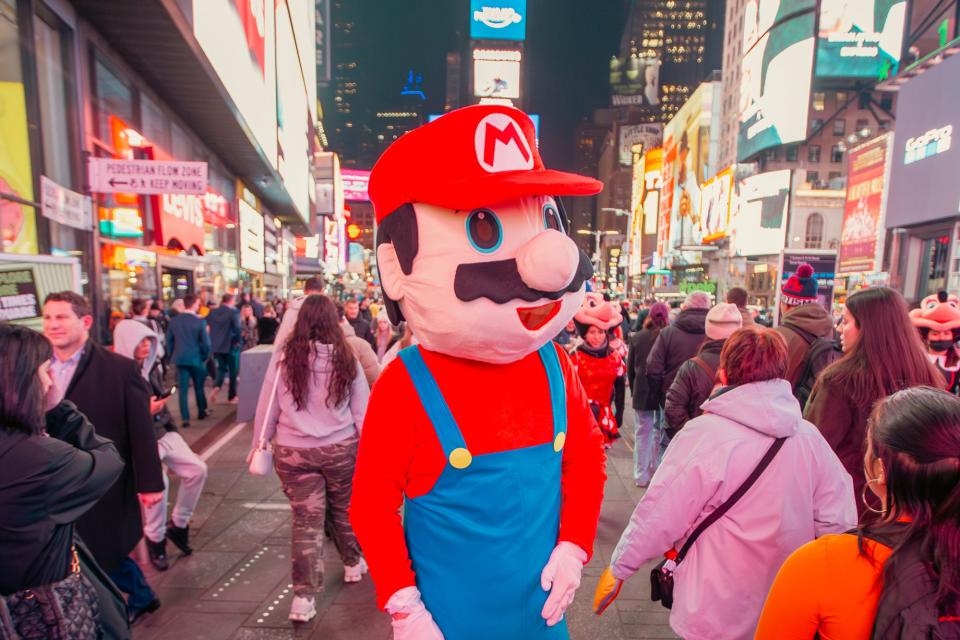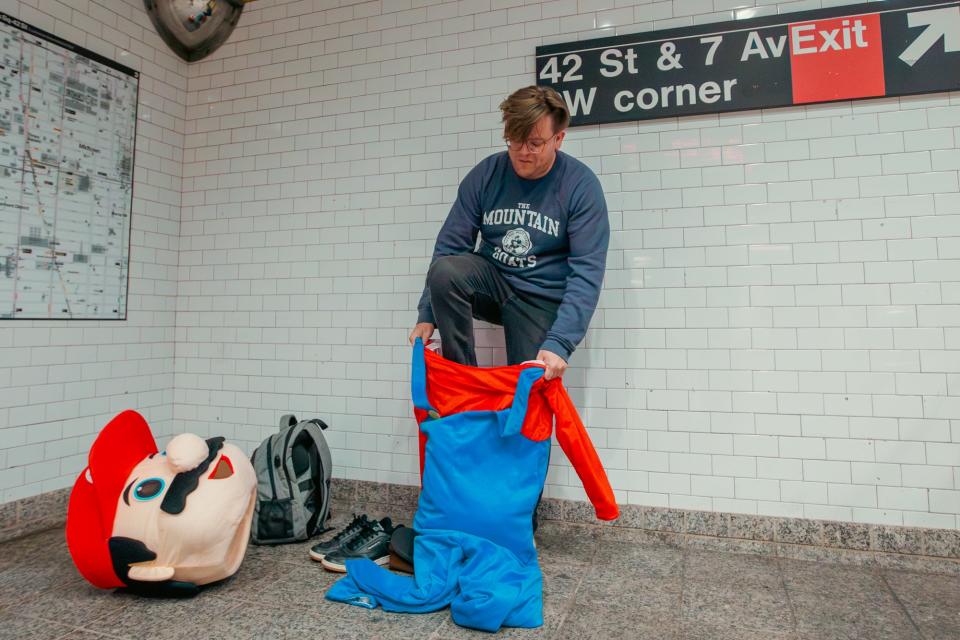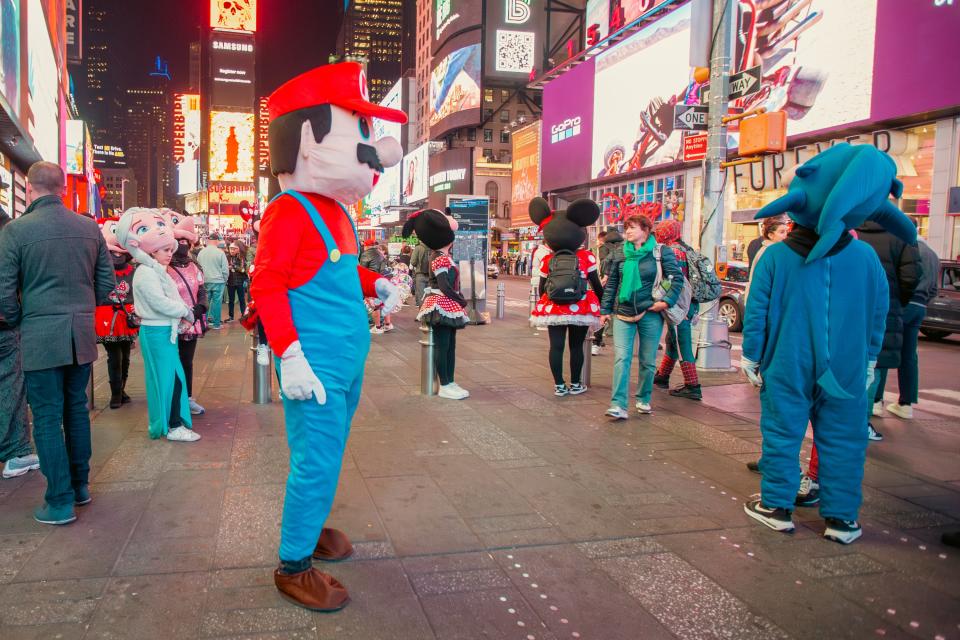I Spent an Evening Dressed as a Life-Sized Mario in Times Square. I Was Not Prepared.
You do not need a permit to become a Times Square street performer. The phalanx of Mickeys, Minnies, and Elmos—men of Iron, Bat, and Spider—who exchange photo ops for tips under the silvery television lights between 42nd and 47th streets are doing so on an entirely freelance basis. The workforce is unaccounted for by any government authority, avocational nonprofit, or ruthless private entertainment corporation. The same goes for the buskers hustling on Los Angeles’ Hollywood Boulevard, London’s Piccadilly Circus, or any other seedy public plaza where tourist foot traffic is ripe to be harvested—this job can be yours, immediately, no questions asked, so long as you’re willing to purchase a costume and hit the pavement.
There are certain advantages to this system. Times Square characters aren’t plundered by an onerous, bloodsucking tariff in the same way Uber drivers are. The Disney facsimiles and Marvel ancillaries are typically tipped in cash, and the city of New York has posted plenty of notices reminding gawking onlookers that if you ask one of the Thors to take a picture with your children, they expect compensation beyond gratitude. The labor is self-directed, with flexible hours, and it’s perhaps a bit more emotionally invigorating compared with other soul-crushing, entry-level urban hustles. (Naturally, most of the performers are immigrants, and many of them don’t speak English.)
The downside, of course, is the complete lack of institutional support. Buskers have no helplines to call, no safety nets to catch them, and no bailout funds to appropriate if something goes wrong. The performers operate on the fringes of legal enterprise, constantly vulnerable to rowdy guests, suspicious police officers, and the looming threat of the low season. It all makes the work profoundly isolating and precarious: It’s you and your Mickey ears against the world. At least that’s how I felt while squeezing into a Mario costume—yes, the Italian plumber—next to a broken-down escalator in the bowels of a midtown subway stop on a frosty Monday evening in early November.
It was the only place in all of Times Square that could be used as a changing room, which is to say, it lacked privacy. A stream of passengers walked by, searching for anything to look at other than the 32-year-old man struggling to fit an egg-shaped cardboard headpiece imprinted with the visage of a Nintendo mascot onto his neck. Nothing about the outfit was comfortable, or even especially wearable. The shoes were cloven, polyhedral-like, and destined to disintegrate when taken onto asphalt. The white cartoon gloves had only four fingers on each hand, which was either a baffling manufacturing error or an attempt to replicate the low-res clumpiness of early video game graphics. Most oppressive of all was the dense pocket of fluff stitched underneath the overalls and pneumatically sealed against my body, intending to create the silhouette of a paunch. Assembled together, the regalia was ridiculously tight, totally betraying its XXL tag. If I sat down while wearing it, the fabric threatened to disintegrate into a million pieces.
But I did look like Mario, and in that sense, I had very little to complain about. The escalator deposited me into prime Broadway—I was ready to entertain a city that would hardly notice if I lived or died.

My goal was to make at least one tip during my night as a Times Square character. I didn’t care how much: $1, $2, a Venmo charge, whatever. If I pulled that off—if I could claim to have turned a profit, or at least cut my losses on the subway fare back home—the night would be a success. This was going to be harder than it looked. The last time I had gotten into character, in any theatrical capacity, was when I was 12 and starring in Christian youth group productions within the confines of a nondenominational megachurch in Southern California. The attending audience had been composed solely of corresponding parents who were duty bound to enjoy what they were watching. (We were wreathed with multiple curtain calls every show.)
Street performance is a different tradition entirely. To succeed, you must become a public nuisance within a squall of anxious humanity—boldly in the way on some of the busiest streets in America. The customers you must coerce into photos, and therefore tips, are all going to be late to their Broadway appointments, or fresh off a magnificently expensive and transcendently stressful dinner at Bubba Gump Shrimp, and have been ruthlessly machete-ing their way through a legion of identical Marios crowding the walkways all goddamn day before you even step up to the plate. On their most profitable shifts, reported the New York Times in 2014, a midtown busker can hope to generate $200 over the course of a standard 9-to-5 session—averaging about 20 customers an hour. It’d take me months to develop both the Disneyland-quality poses and pool-hall shakedown instincts to reach those heights, which is why I set my bar much lower. Again, all I wanted was to leave Times Square with $1.
Only, I couldn’t see shit with the costume on, which was the issue I had been most concerned about. The ensemble I had purchased was from a dubious website called ShopPajama—a chintzy and vaguely “overseas” digital storefront that seems to specialize in professional-grade bootleg costumes of licensed characters. The Mario number I ordered—listed, on the website, as “Fashion Game Character Super Mario Cartoon Mascot Costume”—retails for $236. The interior of Mario’s gigantic, hollowed-out skull was equipped with a helmet and an elastic chinstrap, ensuring that performers will not be suddenly decapitated by a strong gust of wind.
With the helmet locked in, the wearer has two options to receive and process visual information. You can stare down at your feet through the open crevice in Mario’s smile, giving you the barest sense of directional orientation. Or you can focus, with all of your might, on the teensy bit of visible light coming in through the two mesh-covered pinholes pricked out of Mario’s eyes, which feels sort of like looking at the world through a thick glass of oat milk. Everything else inside the headgear is covered in opaque industrial foam, robbing the wearer of their peripheral faculties, optical integrity, and all ambulatory confidence to speak of. I could barely make it to the living room without bumping into something. The stakes were going to be much higher on Sixth Avenue.
Times Square is beautiful when you judge it by aesthetics alone. Yes, plenty of great American sights are more spiritually fulfilling than this Cathedral of Stuff, but if you’re willing to set aside those exasperating anti-capitalist ethics for a few moments, I recommend letting the financial majesty of midtown wash over you. There is truly no joy quite like becoming entranced by a particularly sublime Coca-Cola advertisement, or being inexplicably inspired to take a picture of the Disney Store, and letting your brain cells atrophy away in dumbstruck glory. No, the only problem with Times Square is the obnoxious people who occupy it, and as I stood under the scarlet glow of an H&M sign, dressed in full Super Mario garb, gesturing toward the young families hurrying by—who were doing everything possible to finish up their Manhattan vacation without getting hustled into oblivion—I felt as if I was finally doing my part to make this city worse.
At last, it was time to busk. I had rehearsed a few fundamental bits of character choreography during Halloween weekend, when I donned the Mario suit for trick-or-treaters, and did my best to replicate them here. I’m not a professional, so my Mario did not floss or hit the Griddy or provide anything worthy of TikTok virality you might find in the more seasoned performers. But Mario did rub his oblong cheeks and indulge in a clumsy, slow-motion sashay akin to Billy Crystal’s white man’s overbite. I was winging it, more or less, and at first, I was rewarded with outright invisibility. In fact, my first real interaction with a civilian was when a Times Square drifter blindsided me with a slap to the dome. It wasn’t violent, but it wasn’t exactly welcoming either. Frankly, that’s the only greeting I deserved.

So began my search for a friendly corner, where I could get the hang of the rudiments of busking and hopefully make some money without the threat of getting punked. One of New York City’s greatest attributes is how few people pay attention to you, even if you’re buckled over in a graceless Mario squat waiting for a crosswalk to shine white. I scrambled toward a dining plaza near the Hard Rock Hotel and found some game bystanders, with whom I had slightly better luck. A few awed children, so essential to this particular hustle, made eye contact with me. I could hear their soft, nebulous cries of “Mario!” in the air, as they were shuttled off by their parents to their next destination and away from my distraction. Nobody had stopped me for a photo yet, but we were getting demonstratively closer to pay dirt, and I was actually starting to enjoy the night. You’d be surprised just how insulated from shame you can feel while sheathed in an identity-concealing mascot. Yes, I was dressed ridiculously in the most public arena of America’s largest city, but I kept the nauseating self-consciousness at bay.
It is true that the business of Times Square busking can grow a little ragged in its deregulation. Page through the New York Post archives, and you’ll find stories of aggrieved Spider-Men involved in brawls, or lecherous Elmos getting booked for inappropriate touching, or a Hello Kitty and a Minnie Mouse sparking a war over tips. All of this is to say that I was a little worried about my first encounter with another street performer, in the sense that I would be wading into a cloistered microindustry buttressed with decades of unwritten rules and arcane courtesies that I simply could never decode in a single evening. Not only was I competition, but I was an enemy—and I couldn’t blame them if they felt that way.
However, when I first came across a gaggle of fellow buskers—all of whom looked downright resplendent, glittering in the nuclear fluorescent lights of a nearby Forever 21—my Mario was given a hero’s welcome. A jubilant, beer-bellied Spider-Man pulled me into a loose congregation of gawkers and peppered me with rapid-fire Brooklyn Italian (“Hey, Mario, that’s a spicy meatball!” and so on and so forth). I responded with some novice busking maneuvers of my own—a pair of finger guns or something like that—and we were off to the races. Look at that! Crowd work. Improv. I was right at home. The solidarity between street performers knows no bounds.
But a few moments later, after the Spider-Man disappeared from my vision, I waddled up to a different performer—this one dressed as Sonic the Hedgehog, Mario’s eternal cross-brand rival—and put my hand out for a fist bump. The Sonic, to my dismay, refused to reciprocate. Mario had received the cold shoulder. That’s when I knew I was in trouble.
The spell was broken. The good vibes had evaporated. There was no good-hearted Spider-Man to save me now. Through the murky eyelines of Mario, I saw a pair of twin Minnie Mouses—both of them unmasked—staring directly at me, a disconcerting combination of confusion and simmering displeasure painted on their faces. Maybe they believed I was encroaching on their provincial grind, maybe they could smell the ineffable stench of media on me, or maybe they were simply trying to identify who this unfamiliar Mario was, and if he represented a friend or a foe. Regardless, I know when I am not wanted, and I certainly didn’t intend to cause any problems, so I took my services farther down the block before a confrontation could erupt. Thank God I was in disguise.

It had been almost an hour since I’d first arrived in midtown, and my tip jar was still empty. Busking is hard work. You’ll fail far more than you succeed. So I ventured to the heart of Times Square, among a forest of Titantrons, ready to make a last stand. I noticed that some of the other performers were cultivating customers without wearing their masks. Instead, they waved families over as mundane, flesh-and-blood human beings before reapplying their costumes and transforming back into cartoon characters for the souvenir shot. All of this appeared to be a heinous violation of the Disneyland code, but the flatness of that approach did seem efficient. After all, who has time for immersive character work when you’re freelance? So I removed my sweat-stained plumber’s head and made my pitch to the enveloping flock of tourists as a flat-out carny, rather than a beloved mascot: “Hey, do you want a picture with Mario?”
I hate to say it, but the approach worked like a charm. Minutes after I ditched the helmet, a man asked me if I would take a photo with his two kids. They seemed to be about 7 or 8 and looked adorable in their miniature puffer jackets. I was overjoyed to oblige. We found a bit of empty pavement next to a halal cart—an ideal New York composition—and my Mario hit a dab while the children smiled toward their father’s phone. We wrapped up the shoot, and the dad thanked me in a way that left just enough transactional air in the exchange for me to pounce. Here it was: the moment of truth. I needed to ask for a tip and consummate my destiny.
And yet, I couldn’t pull the trigger. The demand got stuck in my throat; my four-fingered palm remained closed. The would-be customer receded back into the Times Square morass, with the dollar he owed me safely ensconced in his wallet. A missed opportunity, but my hesitation didn’t shock me. Sure, I could dress up as Mario and stalk the corridors of midtown, but I could never internalize the mercenary instincts of the busking craft. Tips simply aren’t a matter of my personal material subsistence—asking for money makes me feel guilty; I am a lucky man indeed.
Instead, I took satisfaction in the fact that I’ll forever be standing in the background of a family photo, smiling wide beneath Mario’s cold, dead eyes, codifying a formative image of New York for a couple of strangers. They won’t be able to tell the story of their vacation without me. That, my friends, is what the job is all about.

